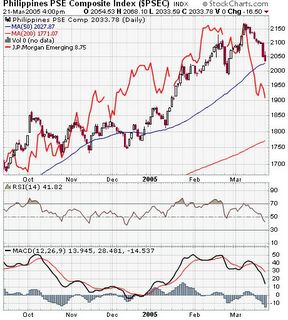Prudent Investor Comments…
Evidences are mounting that the Phisix sell-offs are of class related and has little to do with domestic developments. This report from Bloomberg accentuates that currencies, bonds and stocks in emerging markets have ALL been thrashed.
I would consider this though, an evanescent sell-off considering that, one, emerging assets have been streaking red hot and requires some cooling off or profit taking, and two, commodity prices in general remain buoyant which means that the primary revenue drivers of most emerging markets are still bustling.
Further, this queasiness has also been due to speculations on the US Fed’s move tonight, if it would drop its ‘measured pace’ of hiking rates and open its doors to a more aggressive stance which is currently boosting the US dollar at the expense of emerging market assets.
Emerging Market Bonds, Currencies and Stocks Extend Declines
March 21 (Bloomberg) -- Emerging market bonds, stocks and currencies fell, extending last week's declines, as investors shunned riskier assets amid expectations rising oil prices will stoke inflation, pushing U.S. interest rates higher.
Brazil's benchmark bond maturing in 2040, the most traded emerging-market security, fell to a four-month low. Among stock markets, Pakistan's declined the most, losing 4.2 percent. Shares also dropped in Turkey, Russia and Argentina, while the currencies of Slovakia, Poland, the Czech Republic and Romania also weakened.
Surging oil prices and rising government bond yields in the U.S., the world's biggest economy, are curbing investor appetite for higher-risk assets, which were among the best performers in 2004. Concern deepened after General Motors Corp., the world's third-biggest corporate borrower, on March 16 forecast its biggest quarterly loss since 1992.
``Risk appetite is fading fast,'' said Jean-Dominique Butikofer, who manages $850 million of emerging-market debt at Julius Baer & Co. in Zurich. General Motors' announcement last week had a ``negative psychological impact. Emerging markets are coming under pressure.''
Average spreads on emerging-market debt widened today, rising 5 basis points to 368 basis points, or 3.68 percentage points, according to JPMorgan Chase & Co.'s EMBI Plus Index.
Brazil's 11 percent bond due 2040 fell as much as 1.4 cents on the dollar and was down 0.1 cent to 112.3 at 2:50 p.m. in New York. Its yield rose 1 basis point to 9.76 percent. Brazil's 8 percent bond due 2014 fell 0.4 cent to 99.69.
Venezuela's benchmark 9.25 percent bond that matures in 2027 dropped to its lowest level since October while Mexico's 8.125 percent bond maturing in 2019 slipped to a two-month low.
Emerging market assets are being hurt by speculation the Federal Reserve may signal that it plans to boost the pace of interest-rate increases. By June, the Fed will stop using the term ``measured'' to describe the pace of its interest-rate increases, according to 13 of the 22 firms that trade with the Fed.
Fed Concern
The Fed will raise its benchmark overnight rate by a quarter- point tomorrow to 2.75 percent, the seventh increase since June, according to 93 of 101 economists in a separate poll.
``Everything in Brazil and Latin America right now is about U.S. rates,'' said Pedro Tuesta, senior Latin America economist for London-based 4Cast Inc. in Washington D.C. ``With the possibility that the Fed may change the tone and speed of rate increases, there is less appetite for emerging-market risk.''
Morgan Stanley Capital International Inc.'s Emerging Markets Index of stocks in Eastern Europe, the Middle East, Asia and Latin America fell 0.7 percent today, extending its losing streak to six consecutive days. That's the longest run of declines since May.
Pakistan, Russia, Argentina
Pakistan's Karachi Stock Exchange 100 Index dropped 4.2 percent, Russia's Moscow Interbank Currency Exchange Index fell 1.8 percent and the Argentina Merval Index slipped 2.5 percent.
U.S. 10-year Treasury yields are near a seven-month high on concern rising energy costs will fuel inflation. Crude oil for April delivery fell 10 cents today to $56.62 a barrel on the New York Mercantile Exchange. Oil touched $57.60 a barrel on March 17, the highest for a contract closest to expiration since trading began in 1983. Prices are up 49 percent in the past year.
The yield on the benchmark 4 percent U.S. note due February 2015 was at 4.52 percent today, within 6 basis points of its highest since July.
``Investors' appetite for risk, which has been huge, is on the wane,'' Morgan Stanley's London-based chief fixed-income strategist Joachim Fels wrote in a report published on March 18. ``The bull-run in all the major fixed-income asset classes appears to be over.''
Currencies
The Slovak koruna dropped 2 percent against the dollar today, the biggest decline among 61 currencies tracked by Bloomberg. The Turkish lira lost 1.7 percent, the Czech koruna 1.9 percent and the Romanian leu 1.6 percent.
``This isn't a rout but there's more risk adjustment going on,'' said Jon Harrison, a currency strategist at Dresdner Kleinwort Wasserstein in London. ``The market clearly thinks there's more to come.''
Emerging Europe, Middle East and Africa stock mutual funds last week had their first weekly outflow of money in three months, according to EmergingPortfolio.com. The funds lost a net $4.4 million the week to March 16, the Boston-based fund tracker said in an e-mail. The funds have taken in $2.85 billion in new money this year, more than the $2.18 billion inflow for all of 2004, the data showed.




